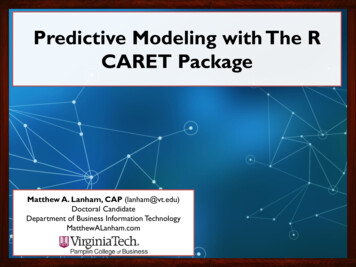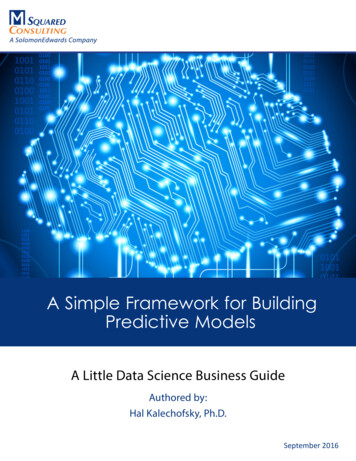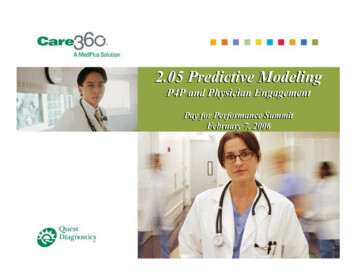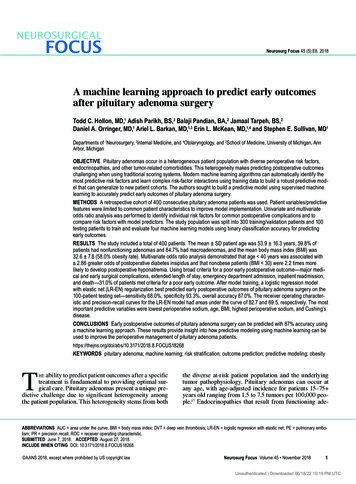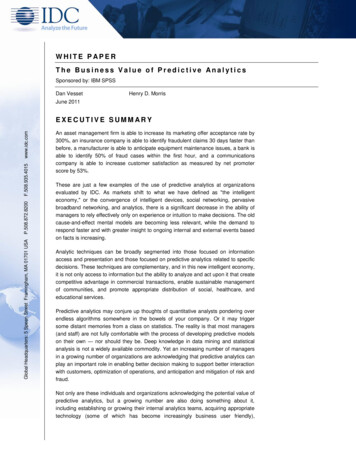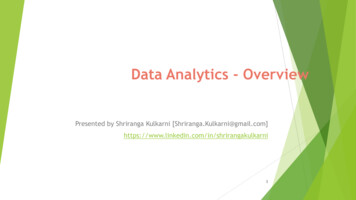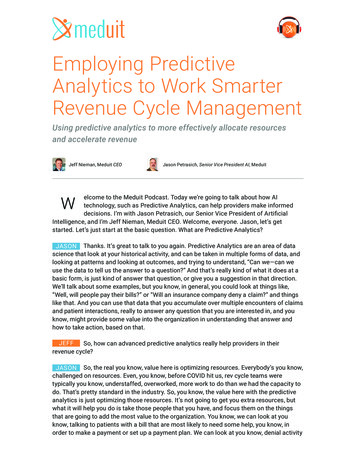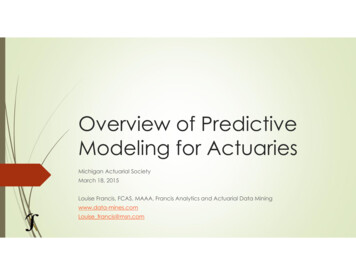
Transcription
Predictive Model Performance:Offline and Online Evaluations Jeonghee Yi , Ye Chen, Jie Li, Swaraj Sett, Tak W. YanMicrosoft Corporation1065 La Avenida st.Mountain View, CA 94043{jeyi, yec, lijie, swasett, takyan}@microsoft.comABSTRACTKeywordsWe study the accuracy of evaluation metrics used to estimatethe efficacy of predictive models. Offline evaluation metricsare indicators of the expected model performance on realdata. However, in practice we often experience substantialdiscrepancy between the offline and online performance ofthe models.We investigate the characteristics and behaviors of theevaluation metrics on offline and online testing both analytically and empirically by experimenting them on onlineadvertising data from the Bing search engine. One of ourfindings is that some offline metrics like AUC (the Area Under the Receiver Operating Characteristic Curve) and RIG(Relative Information Gain) that summarize the model performance on the entire spectrum of operating points couldbe quite misleading sometimes and result in significant discrepancy in offline and online metrics. For example, for clickprediction models for search advertising, errors in predictions in the very low range of predicted click scores impactthe online performance much more negatively than errors inother regions. Most of the offline metrics we studied including AUC and RIG, however, are insensitive to such modelbehavior.We designed a new model evaluation paradigm that simulates the online behavior of predictive models. For a setof ads selected by a new prediction model, the online userbehavior is estimated from the historic user behavior in thesearch logs. The experimental results on click predictionmodel for search advertising are highly promising.evaluation metric, offline evaluation, online evaluation, AUC,RIG, log-likelihood, prediction error, simulated metric, online advertising, sponsored search, click prediction1.INTRODUCTIONIn the field of machine learning, evaluation metrics are often used to judge and compare the performance of predictivemodels on benchmark datasets. It is quite clear that goodquantitative assessments of their accuracies are essential tobuild successful predictive systems. Though a large array ofevaluation metrics are already available [5, 13] and de factostandard metrics may exist for specific prediction problems,they do not come without limitations and drawbacks. Previous research has shown that some metrics may overestimatethe model performances for skewed samples [9, 10, 14], andthere exist variations of a metric that lead to different resultsunder certain circumstances like cross validation [14].For a typical machine learning problem, training and evaluation (or test) samples are selected randomly from the population the model needs to be built for, and predictive models are built on the training samples. Then the learned models are applied on the evaluation data, and the qualities ofthe models are measured using selected evaluation metrics.This is called offline evaluation.In addition, highly complex modern applications, such assearch engines like Google and Bing, and online shoppingengines like Amazon and eBay, often conduct online evaluations of best performing offline models on a controlled ABtesting platform (online evaluation). The online AB testing platform may set up two isolated testing environmentsthat are identical except one is set up with the baseline (orcontrol) model, and the other one with the new model tobe tested. They send a predefined amount of live traffic toeach environment for the same time period. The differencesin online user behaviors, such as clicks and the number ofsearches per user, and some other performance metrics, suchas revenue per search, are evaluated to determine whetherthe difference is statistically significant before making a finallaunch decision of the new model. The assumption here isthat the online performance metric would be better, if thenew model delivered better quality results.One problem with the model evaluations in reality is thatsometimes the improvement of model performance in offlineevaluation does not get realized as much, or sometimes getsreversed in online evaluation. Unlike static offline evaluation, online testing even under the controlled environmentis highly dynamic, of course, and many factors not consid-Categories and Subject DescriptorsH.4 [Information Systems Applications]: Miscellaneous;D.2.8 [Software Engineering]: Metrics—complexity measures, performance measures Contact authorPermission to make digital or hard copies of all or part of this work for personal orclassroom use is granted without fee provided that copies are not made or distributedfor profit or commercial advantage and that copies bear this notice and the full citation on the first page. Copyrights for components of this work owned by others thanACM must be honored. Abstracting with credit is permitted. To copy otherwise, or republish, to post on servers or to redistribute to lists, requires prior specific permissionand/or a fee. Request permissions from permissions@acm.org.KDD’13, August 11–14, 2013, Chicago, Illinois, USA.Copyright 2013 ACM 978-1-4503-2174-7/13/08 . 15.00.1294
ered during the offline modeling play a role in the results.Nevertheless, these observations raise a question if there exist fundamental biases or limitations of the offline evaluationmetrics that lead to such discrepancies.Another problem is comparing performance of predictivemodels built with different kinds of data, especially datawith rare events. Rare events occur in disproportionatelylower frequency than the counterparts, thus result in skewedsample distributions between the classes. This is a quitecommon phenomenon in real world problems. Examples ofrare events include clicks on web search result links, clicks ondisplay ads, and making a purchase after clicking on product ads. Previous research has shown that some metrics mayoverestimate the model performance for skewed samples[9].The observations lead into the following questions. Withthe bias, how can we interpret and compare the model performance applied to different kinds of data ? For example,when we build prediction models for text ads and displayads, can we use the offline metrics as comparative measuresto predict their true performance ? Suppose we know thetrue performance of a model, and we get equivalent offlinemetrics of the other model. Can we estimate the true performance of the other model ? If we can’t, what kind ofmetrics should we use instead ?We propose a new model evaluation paradigm: simulatedmetrics. We implemented auction simulation for offline simulation of online behaviors and used the simulated metricsto estimate the online model performance of click prediction models. Since simulated metrics are designed to simulate online behaviors, we expect they would suffer less fromthe performance discrepancy problem. Also, since simulatedmetrics directly estimates the online metrics such as userCTR (Click-Through Rate), they can be directly comparable even if they are for models built on different kinds ofdata.The contributions of this paper are four-fold:offline and online performance of the models deployed onreal-time production traffic of the Bing search engine. Finally, we summarize our findings and suggest best practiceguidelines based on our analysis and lessons from real worldexperiences on online advertising data.2.PRELIMINARIESThe target application of our study is online advertising.Some of the problem areas discussed in this study might bespecific to the domain. In this section, we briefly reviewmajor areas of online advertising, and those who are interested may find excellent tutorials on the references providedbelow.2.1Online AdvertisingSponsored (or paid ) search [11, 21, 28, 34] such as GoogleAdWords and Bing’s Paid Search, is search advertising thatshows ads alongside algorithmic search results on search engine results pages (SERPs). Sponsored search reaches outto people actively looking for information about productsand services online, thus has relatively higher click-throughrate (CTR) compared to other types of advertising.Advertisers bid on keywords through a Generalized SecondPrice (GSP) auction [11]. Bidders with highest rank scores(r ) win the auction:r b · pα(1)where b is a bid amount, p is estimated position-unbiasedCTR, and α is a parameter, called click investment power.If α 1, the auction prefers ads with higher estimated CTRs,otherwise, ads with higher bids. Rank score is estimatedCTR weighted by cost per click bid.Ads are allocated in the descending order of estimatedrank scores, and the auction winners pay price per click(a.k.a. cost per click, or CPC) for their ad impression onlywhen people click on their ads. In a GSP auction, CPCdepends on the next higher bidder’s bid amount, ci : We analyze the characteristics and limitations of offlineevaluation metrics and share our findings about theirbehaviors on offline and online data.ci We share our experience on training, evaluation, anddeployment of click prediction models for productiononline advertising system on the Bing search engine,and offer best practice guidelines for large-scale predictive model evaluation.bi 1 · pαi 1pαiUser clicks are highly dependent on the position of theads[7, 15]. Typically ads shown on the section above algorithmic search results (called mainline) get higher CTR thanthose shown to the right of the algorithmic results (calledside bar ). Within the same section, the higher the ad location, the more clicks it gets for the same ad.Display ads[32] are graphical ads that appears on websites, content pages, or applications such as instant messaging, email, etc. Contextual ads[7], such as Google AdSenceor Bing’s Contextual Search are contextually optimized adsplaced on publisher’s sites often with customized look andfeel of the publisher’s site.Accurate estimation of the probabilities of user clicks iscritical for the efficiency of ad exchange [25]. The problemof estimating click probabilities has been studied extensivelyboth for algorithmic search [24, 30, 31, 36] and for ads[6, 8,16, 27]. To our knowledge, this is the first paper in open literature that proposes and applies simulated metrics asmodel evaluations paradigm. To our knowledge, this is again the first paper in openliterature that analyzes the problems of offline evaluation metric behaviors that lead to online and offlineperformance discrepancy of predictive models.The remaining parts of this paper are organized as follows.In the next section, we briefly review online advertising andbinary classification error measurement. In Section 3, wesurvey predictive model evaluation metrics in open literature. We then review some of the metrics frequently usedin the surveyed literature in Section 4. In Section 5, we describe the problems and limitations of the AUC and RIGmeasures on large scale click prediction models for sponsored search. In Section 6, we discuss the discrepancy of the2.2Binary Classification Error MeasurementConsider a feature vector x, and observed binary responses,y {0, 1}. x is considered as a realization of a random vector X, and y as a Bernoulli random variable Y. The class1 probability η P [Y 1] is a function of x: η(x) 1295
PE (prediction Error): MSE (Mean Square Error),MAE (Mean Absolute Error), RMSE (Root Mean SquareError), etcP [Y 1 X x]. A binary classifier predicts samples withη(x) c as class 1, where c is a parameter: otherwise, predicts as class 0.The efficacy of the predictions is estimated using various criteria including the primary criteria such as predictionerror, and surrogate criteria such as log-loss and squared error loss [4]. Primary criteria are used to estimate the classdirectly, and surrogate criteria are to estimate the class prediction probability. Prediction (or misclassification) error isintrinsically unstable for estimating model performance. Instead, log-loss and square error loss are often used for probability estimation and boosting, and defined as follows:. DCG-based: DCG (Discounted Cumulative Gain), NDCG(Normalized DCG), RDCG (Relative DCG), etc IR (Information Retrieval): Precision/Recall, F-measure,AP(Average precision), MAP(Mean Average Precision),RBP (Rank-Based Precision), MRR (Mean ReciprocalRank), etc misc: everything else that does not belong to one ofthe other categories Log-loss:L(y p) log(py (1 p)1 y ) ylog(p) (1 y)log(1 p)NDCG is a de facto standard metric of choice for searchranking algorithms. Even though probability based metrics are relatively popular for advertising domain, there stilldoesn’t exist a single metric that dominates the domain likeNDCG for search ranking problems,. Despite previous research that suggest AUC is much more reliable[3, 29, 22],there were only 2 papers we found that measured AUC. Weapplied AUC on the click prediction (pClick ) problem onadvertising domain, and found that it was one of the mostreliable metrics, but not without problems. We will discussabout individual metrics in detail in the next section. Squared error loss (or quadratic loss):L(y p) (y p)2 y(1 p)2 (1 y)p2where p is the estimated probability of η(x). The equalityof squared error loss holds only for binary classifiers: i.e.,y {0, 1}.Log-loss is the negative log-likelihood of the Bernoullimodel. Its expected value, -ηlog(p) - (1 η)log(1 p), iscalled Kullback-Leibler loss[19] or cross-entropy.2.34.Experimental Data SetThroughout the paper we show motivating examples andthe analyses of the click prediction model performance onMicrosoft Bing search engine. We sampled data from Bing’ssponsored search logs during the time period of Jun. thruAug., 2012. We used two sets of data: one sampled frompaid search data on Bing, and another from the contextualads on partner websites on Microsoft publisher network.3.EVALUATION METRICSWe focus our review on the metrics primarily used forclick prediction problems. A click prediction model estimates position-unbiased CTRs of ads for the given query.We treat it as a binary classification problem.We exclude NDCG from our review because it is designedto prefer a ranking algorithm that places more relevant results at earlier ranks. As discussed in section 2.1, in searchadvertising, the ranks are determined not by the pClick (i.e.,the estimated click) scores, but by the rank scores. Therefore, measuring the performance of pClick by the rank ordersusing NDCG is inappropriate.We also exclude Precision-Recall (PR) analysis on our review because there is a connection between PR curve andROC (Receiver Operator Characteristic) curve, thus a connection between PR curve and AUC [9]. Davis and Goadrichshow that a curve dominates in ROC space if and only if itdominates in PR space [9].SURVEY OF METRICSWe studied papers from the proceedings of the International World Wide Web Conference (WWW), the ACM International conference on Web Search and Data Mining Conference (WSDM), and the ACM SIGKDD International Conference on Knowledge Discovery and Data Mining Conference (SIGKDD) in years 2011 and 2012 in the area of algorithmic search and online advertising. We manually categorized the topic areas of the papers and the evaluationmetrics they used. Table 1 summarizes the results.There are four major topical categories we found: recommendation, search, online advertising, and CTR estimation.Search and online advertising are further divided into subcategories. The count of higher level category is sum of thecounts of its sub-categories.The categories of metrics are divided into offline and online metrics. Online metrics include model performancestatistics such as ad impression yield, ad coverage, and userreaction metrics, such as CTR and the length of user sessions. Offline metrics are categorized into the following sixtypes [18, 1, 26, 35]:4.1AUCConsider a binary classifier that produces the probabilityof an event, p. p and 1-p, the probability the event does notoccur, represent the degree to which each case is a memberof one of the two events. A threshold is necessary in orderto predict the class membership. AUC, or the Area underthe ROC (Receiver Operating Characteristic) Curve[12, 33],provides a discriminative measure across all possible rangeof thresholds applied to the classifier.Comparing the probabilities involves the computation offour different fractions in a confusion matrix: the true positive rate (TPR) or sensitivity, the true negative rate (TNR)or specificity, the false positive rate (FPR) or commissionerrors, and false negative rate (FNR) or omission errors.These four scores and other measures of accuracy derivedfrom the confusion matrix such as precision, recall, or accuracy all depend on the threshold. probability-based: AUC, MLE (Maximum LikelihoodEstimator), etc Log Likelihood-based: RIG, cross-entropy, etc1296
Table 1: A summary of evaluation metrics used by papers accepted to the WWW, the ACM WSDM, and theACM SIGKDD conferences in years 2011 and 2012 in the area of algorithmic search and online d searchsocial search rankingresult clusteringquery classification/suggestiontopic assignmentdistributed searchOnline Advertisingpricing/bid estimationad auctionbid agentstargettingcommerceCTR Estimation (Algo Ads)TotalProbability111Offline MetricsLog Likelihood PE 161121161213221181313784.2The ROC curve is a graphical depiction of sensitivity (orTPR) as a function of commission error (or FPR) of a binaryclassifier as its threshold varies. AUC is computed as follows:1215152201114770RIGRIG (Relative Information Gain) is a linear transformation of log-loss [15, 36]: sort records with descending order of the model predicted scoreslog lossEntropy(γ) c · log(p) (1 c)log(1 p) 1 γ · log(γ) (1 γ)log(1 γ)RIG 1 calculate TPR and FPR for each predicted value plot ROC curve(2)where c and p represent observed click and pClick, respectively. γ represents the CTR of the evaluation data.Log-loss represents the expected probability of click. Minimizing log-loss means that pClick should converge to theexpected click rate and the RIG score increases. Calculate the AUC using trapezoid approximationEmpirically, AUC is a good and reliable indicator of thepredictive power of any scoring model. For sponsored search,AUC, especially AUC measured only on mainline ads, is oneof the most reliable indicators of the predictive power of themodels. A good model (AUC 0.8) usually has statisticallysignificant improvement if AUC improves by 1 point (0.01).The benefits of using the AUC for predictive modelinginclude:4.3 AUC provides a single-number discrimination score summarizing overall model performance over all possiblerange of thresholds. This enables avoiding the subjectivity in the threshold selection.MSEMSE (Mean Squared Error) measures the average of squaredloss:Pn22i 1 (ci · (1 pi ) (1 ci ) · pi )M SE(P ) nwhere pi and ci are pClick and the observed click, respectively, of sample i.NMSE (Normalized MSE) is MSE normalized by CTR, γ: It is applicable to any predictive model with scoringfunction.N M SE(P ) 4.4 The AUC score is bounded between [0,1] with the scoreof 0.5 for random predictions, and 1 for perfect predictions.M SE(P )γ · (1 γ)MAEMean Absolute Error (MAE) is given by: AUC can be used for both offline and online monitoringof predictive models.M AE(P ) n1Xein i 1where ei pi ci is an absolute error.MAE weighs the distance between the prediction and observation equally regardless of the distance to the criticaloperating points. MAE is commonly used to measure forecast error in time series analysis.1297
If the predicted (query, ad) pair does not appear in thehistoric logs, the average CTR (called reference CTR)of ads on the ad-position is used.Empirically it also has a good performance on estimatingthe pClick model efficacy for sponsored search. It is one ofthe most reliable metrics together with AUC.4.5Click curve and reference CTR are derived from the historicuser responses in the search advertising logs.Empirically, auction simulation produces highly accurateset of ads selected by the new model for the given set of operating points. Simulated metric often turns out to be one ofthe strongest offline estimators of online model performance.Prediction ErrorPrediction Error (PE) measures average pClick normalized by CTR:P E(P ) avg(p) 1γPE becomes zero where the average pClick score exactlyestimates the CTR. On the other hand, PE could be stillvery close to zero even when the estimated pClick scores arequite inaccurate with mix of under- and over-estimation ofthe probability as long as the average is quite similar to theunderlying CTR. This makes prediction error quite unstable,and it can not be used to estimate the classification accuracyreliably.4.65.EXPERIENCES WITH THE METRICS ONREAL-WORLD PROBLEMSIn this section we analyze the behaviors, limitations anddrawbacks of various metrics in detail in the context of clickprediction for search advertising. Note that we do not meanto suggest these metrics be dismissed all together due tothe limitations and drawbacks. We rather suggest the metrics be carefully applied and interpreted, especially on thecircumstances where the metrics may produce misleadingestimations.Simulated MetricAlthough online experiments on controlled AB testing environment provides the real performance metrics of modelsunder comparison by user engagement, AB testing environments are pre-set with a fixed set of parameter values, thusthe model performance metrics on the testing enviromentis only for the given set of operating points. Conductingonline experiments over numerous sets of operating pointsis not practical because online experiment is not only verytime consuming, but also could be very expensive in terms ofboth user experience and revenue, if the new model underperforms.Instead of using expensive and time consuming onlineevaluation, the performance of a model over the entire spanof feasible operating points can be simulated using the historic online user engagement data. Kumar, et. al. developed an online performance simulation methods for federated search [20].Auction simulation, first, reruns ad auctions offline forthe given query and selects a set of ads based on new modelprediction scores and/or various sets of operating points.We implemented auction simulation [15] using sponsoredsearch click logs data and produced various simulated metrics. Auction simulation, first, reruns ad auctions offline forthe given query and selects a set of ads based on the newmodel prediction scores. During the simulation, user clicksare estimated using historic user clicks of the given (query,ad) pair available in the logs as follows:5.1AUCWhile AUC is a quite reliable method to assess the performance of predictive models, it still suffers from drawbacksunder certain conditions of sample data. The assumptionthat AUC is a sufficient test metric of model performanceneeds to be re-examined [23].First, it ignores the predicted probability values. Thismakes it insensitive to the transformation of the predictedprobabilities that preserve their ranks. On one hand, thiscould be an advantage as it enables comparing tests thatyield numerical results on different measurement scales. Onthe other hand it also is quite possible for two tests to produce dramatically different prediction output, but with similar AUC scores. It is possible that a poorly fitted model(overestimating or underestimating all the predictions) hasa good discrimination power [17], while a well-fitted modelhas poor discrimination if probabilities for presences are onlymoderately higher than those for absences, for example.Table 2 shows an example of a poorly fitted model thathas even higher AUC score where a large number of negativesamples have very low pClick scores, thus lower CTR. Thishas an effect of lowering the FPR in the relatively higherrange of pClick scores, thus raising the AUC score.Second, it summarizes the test performance over the entire spectrum of the ROC space including the area one wouldrarely operate on. For example, for sponsored search, placing an ad in mainline impacts the CTR significantly, whileit is not as much of a concern how the predicted CTR fitsto the actual CTR once it is shown on mainline or where itis not shown at all. In other words, the extreme right andleft side of the ROC space are generally less useful. Bakerand Pinsky proposed partial ROC curves as an alternativeto entire ROC curves[2].It has been observed that higher AUC does not necessarilymean better ranking always. As shown in Table 3, changesin the sample distribution on either end of FPR impactsthe AUC score quite substantially. Nevertheless the impacton the performance of the model in terms of CTR couldbe the same especially at the practical operating point of If the user click data of the (query, ad) pair is foundin the logs at the same ad diaplay location (call itad-position) as the simulated ad-position, the historicCTR is directly used as the expected CTR. If the (query, ad) pair is found in the logs, but the simulated ad-position is different from the position in thelogs, the expected CTR is calibrated by the positionbiased historic CTR (or click curve). Typically, mainline ads get drastically higher CTR than sidebar ads1for the same (query, ad) pair, and ads at a higher location within the same ad block gets higher CTR forthe same (query, ad) pair [7].1Sidebar ads are ads shown on the ad block at the right sideof algorithmic search results.1298
Table 2: The AUC Anomaly 1: A poorly fitted model has even higher AUC in the presence of a large numberof negative samples concentrated on the low end of pClick score range. (The first table shows a betterl-fittedmodel.)Avg pClickAvg pClick # clicks # no-clicks Actual CTRTPRFPRTrapezoid ActualCTR0.0300003009,7000.0300000.2500 0.00860.00111.00.0200002009,8000.0200000.4167 0.01730.00291.00.0100001009,9000.0100000.5000 0.02600.00401.00.00500050099,5000.0050000.9167 0.11420.06241.00.000100100999,9000.0001001.0000 1.00000.84991.0total1,2001,128,800AUC0.9193Avg pClickAvg pClick # clicks # no-clicks Actual CTRTPRFPRTrapezoid ActualCTR0.0300003009,7000.0300000.2500 0.00100.00011.00.0200 002009,8000.0200000.4167 0.00190.00031.00.0100001009,9000.0100000.5000 0.00290.00041.00.00500050099,5000.0050000.9167 0.01270.00701.00.0001001009,999,0000.0000101.0000 1.00000.946110.0total1,20010,127,900AUC0.9540Table 3: The AUC Anomaly 2: Changes in the sample distribution on either end of FPR impacts the AUCscore quite subtantially, although the actual model performance is quite similar at the practical operationgpoint.Avg pClickAvg pClick # clicks # no-clicks Actual CTRTPRFPRTrapezoid ActualCTR0.0300003,00097,0000.0300000.4545 0.00930.00211.00.0200002,00098,0000.0200000.7576 0.01880.00571.00.0100001,00099,0000.0100000.9091 0.02830.00791.00.00500050099,5000.0050000.9848 0.03790.00911.00.0000101009,999,9000.0000101.0000 97Avg pClickAvg pClick # clicks # no-clicks Actual CTRTPRFPRTrapezoid ActualCTR0.0300003,00097,0000.0300000.4545 0.00930.00211.00.0200002,00098,0000.0200000.7576 0.01880.00571.00.0100001,00099,0000.0100000.9091 0.02830.00791.00.0050001009,999,9000.0000100.9242 0.99040.8820500.00.00001050099,5000.0050001.0000 69Table 4: The AUC Anomaly 3: A poorly fitted model hastable shows a better-fitted model.)Avg pClick # clicks # no-clicks Actual 0.000100100999,9000.000100total1,2001,128,800Avg pClick # clicks # no-clicks Actual 001299the same AUC as a well-fitted model. (The 0110.00290.00400.06240.84990.9193Avg pClickActualCT R1.01.01.01.01.0Avg pClickActualCT R9.79.89.910.010.0
Figure 1: ROC curves of sponsored search and contextual adsFigure 2: The RIG and PE scores over varying CTRof sample data: The RIG scores drop with increasingCTR.the threshold. Because AUC does not discriminate the various regions of the ROC space, a model may be trained tomaximize the AUC score just by optimizing the model performance on the either end of data. This may lead to lowerthan expected performance gain on the real online traffic.Third, it weighs omission and commission errors equally.For example, in the context of sponsored search, the penaltyof not placing the optimal ads in mainline (omission error)far exceeds the penalty of placing a sub-optimal ads (commission error). When the misclassification cost are unequal,summarizing over all possible threshold values is flawed.Lastly, AUC is highly dependent on the underlying distribution of data. The AUC measures computed for twodatasets with different rate of negative samples would bequite different. See Table 4. A poorly fitted model withlower intrinsic CTR has the same AUC as a well-fitted model.This also implies that higher AUC score for a model trainedwith higher rate of negative samples does not necessarilyimply the model has better predictive performance. Figure 1 plots the ROC curves of pClick models for sponsoredsearch and contextual ads. As indicated on the figure theAUC score of contextual ads model is about 3% higher thanAUC of sponsored search, even though the former is less acavg pClick 1.02 for sponsored search vs 0.86 forcurate: actualCT Rcontextual ads.5.2Table 5: Offline and online metrics of a new model(mod
ered during the o ine modeling play a role in the results. Nevertheless, these observations raise a question if there ex-ist fundamental biases or limitations of the o ine evaluation metrics that lead to such discrepancies. Another problem is comparing performance of predictive models built with di erent kinds of data, especially data with rare .
